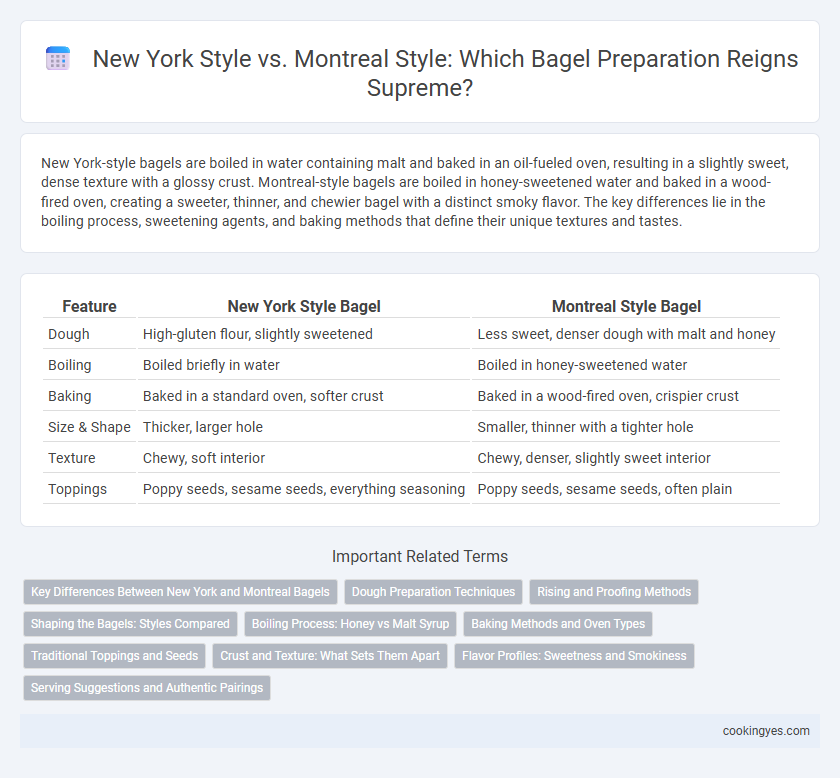New York-style bagels are boiled in water containing malt and baked in an oil-fueled oven, resulting in a slightly sweet, dense texture with a glossy crust. Montreal-style bagels are boiled in honey-sweetened water and baked in a wood-fired oven, creating a sweeter, thinner, and chewier bagel with a distinct smoky flavor. The key differences lie in the boiling process, sweetening agents, and baking methods that define their unique textures and tastes.
Table of Comparison
| Feature | New York Style Bagel | Montreal Style Bagel |
|---|---|---|
| Dough | High-gluten flour, slightly sweetened | Less sweet, denser dough with malt and honey |
| Boiling | Boiled briefly in water | Boiled in honey-sweetened water |
| Baking | Baked in a standard oven, softer crust | Baked in a wood-fired oven, crispier crust |
| Size & Shape | Thicker, larger hole | Smaller, thinner with a tighter hole |
| Texture | Chewy, soft interior | Chewy, denser, slightly sweet interior |
| Toppings | Poppy seeds, sesame seeds, everything seasoning | Poppy seeds, sesame seeds, often plain |
Key Differences Between New York and Montreal Bagels
New York bagels are typically larger, softer, and boiled in water with malt syrup before baking, resulting in a chewier texture and a slightly sweet flavor. Montreal bagels are smaller, denser, and boiled in honey-sweetened water, then baked in a wood-fired oven, giving them a distinct sweetness and crispier crust. The inclusion of malt in New York style contrasts with the use of honey in Montreal style, influencing both flavor and texture differences between the two iconic bagel types.
Dough Preparation Techniques
New York style bagels utilize a high-gluten flour dough that undergoes a longer fermentation period, resulting in a chewier texture with a slightly sweet flavor. Montreal style bagels use malt syrup in the dough and are boiled in honey-sweetened water, creating a denser, sweeter crust with a more compact crumb. The dough preparation techniques of both styles significantly influence the final bagel's texture and taste profile, showcasing regional distinctions in traditional Jewish baking.
Rising and Proofing Methods
New York-style bagels undergo a longer, slower fermentation with cold proofing, allowing the dough to develop complex flavors and a chewy texture. Montreal-style bagels are proofed at warmer temperatures and for shorter periods, resulting in a denser crumb and sweeter flavor due to the use of malt and honey in the dough. These distinct rising and proofing methods contribute significantly to the unique texture and taste profiles that differentiate New York bagels from Montreal bagels.
Shaping the Bagels: Styles Compared
New York-style bagels are hand-rolled to create a smooth, evenly sized ring with a slightly larger hole, contributing to their denser, chewier texture after boiling and baking. In contrast, Montreal-style bagels are shaped by hand-rolling thinner dough ropes that are then twisted into a smaller, tighter ring, resulting in a sweeter, denser bagel with a smaller hole. These distinct shaping methods influence the bagels' final texture, with New York's emphasizing chewiness and Montreal's offering a more compact crumb.
Boiling Process: Honey vs Malt Syrup
New York style bagels undergo boiling in water sweetened with honey, which imparts a subtle sweetness and a shiny, slightly chewy crust. Montreal style bagels are boiled in water enriched with malt syrup, contributing to a denser texture and a richer, caramelized flavor profile. The distinct sweeteners in the boiling process significantly influence the bagel's crust texture and overall taste, defining the unique identity of each regional style.
Baking Methods and Oven Types
New York-style bagels are boiled briefly in water with malt syrup before baking in a deck oven, resulting in a chewy interior with a shiny crust. Montreal-style bagels undergo a longer boil in honey-sweetened water, then bake in a wood-fired oven, creating a denser texture and slightly sweeter flavor. The distinct baking methods and oven types are essential in defining the unique characteristics of each bagel style.
Traditional Toppings and Seeds
New York-style bagels feature a chewy texture with a shiny crust, often topped with poppy seeds, sesame seeds, or everything seasoning blends combining garlic, onion, and salt. Montreal-style bagels are smaller, sweeter, and denser, typically boiled in honey-sweetened water before baking, and commonly adorned with sesame seeds or occasionally poppy seeds. Traditional toppings in New York emphasize savory flavors, while Montreal bagels lean towards a subtly sweet and nutty profile due to their unique preparation and seed choices.
Crust and Texture: What Sets Them Apart
New York-style bagels feature a dense, chewy texture with a shiny, crisp crust often achieved through boiling in malt-infused water before baking. Montreal-style bagels are smaller, sweeter, and thinner, with a notably crispier crust due to boiling in honey-sweetened water and baking in a wood-fired oven. The distinct boiling methods and baking techniques create unique crust textures and densities that define each style's characteristic bite.
Flavor Profiles: Sweetness and Smokiness
New York-style bagels feature a slightly sweet flavor with a dense, chewy texture, often enhanced by boiling in water with malt syrup before baking. Montreal-style bagels offer a distinctly sweeter and more aromatic profile, achieved by boiling in honey-sweetened water and baking in wood-fired ovens that impart a subtle smokiness. The contrast arises from New York's malt-induced sweetness versus Montreal's honey infusions and smoky finish, creating unique taste experiences in each regional bagel.
Serving Suggestions and Authentic Pairings
New York-style bagels, characterized by their dense and chewy texture, are traditionally served with cream cheese and smoked salmon, often garnished with capers and red onions for a classic deli experience. Montreal-style bagels, sweeter and thinner with a kettle-boiled, honey-sweetened crust, pair authentically with butter or cream cheese, and are commonly enjoyed alongside Montreal-style smoked meat or imported European cheeses. Both styles complement fresh deli meats and pickled accompaniments, enhancing their signature flavor profiles in authentic culinary pairings.
New York style vs Montreal style for bagel preparation Infographic

 cookingyes.com
cookingyes.com